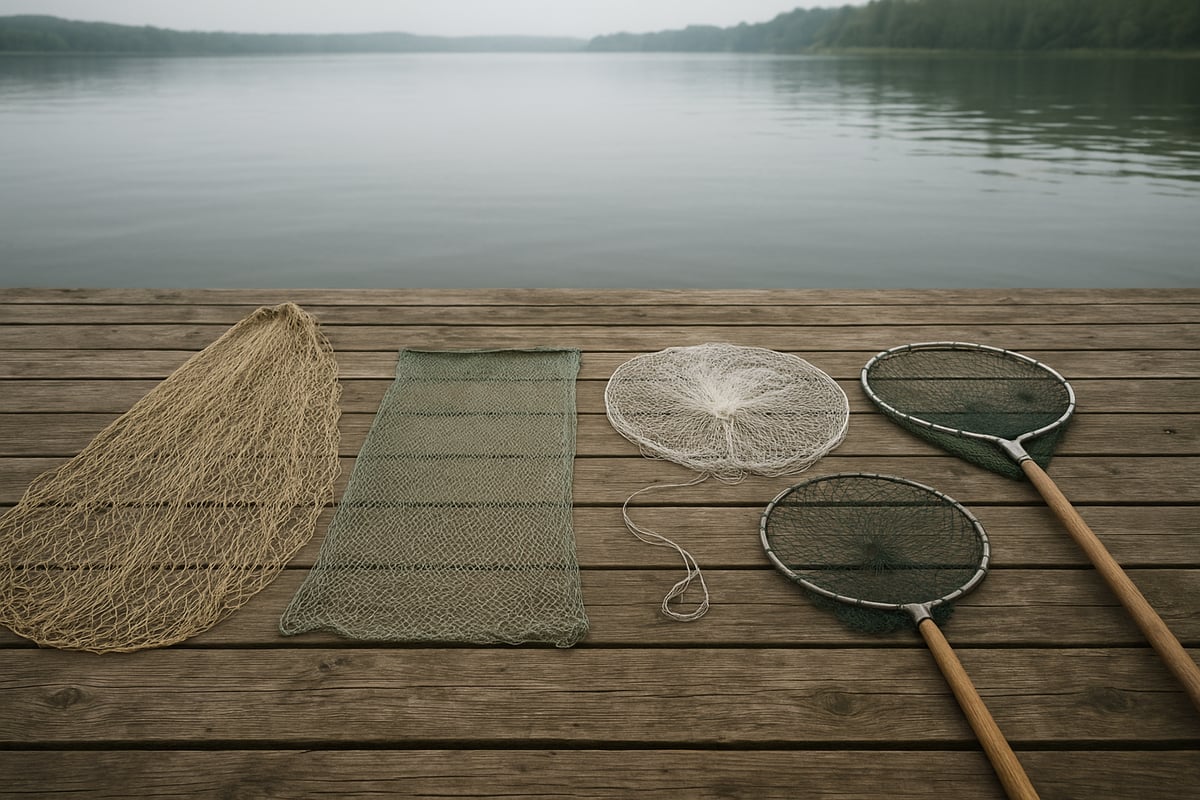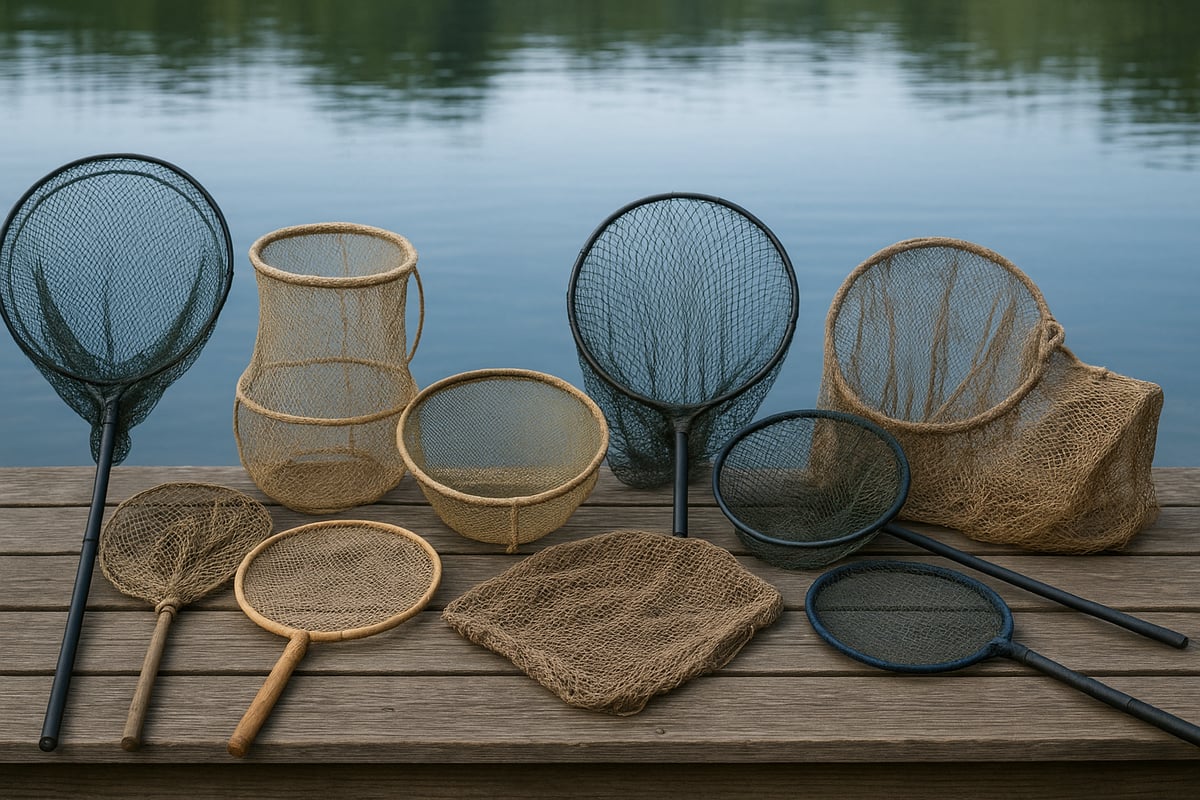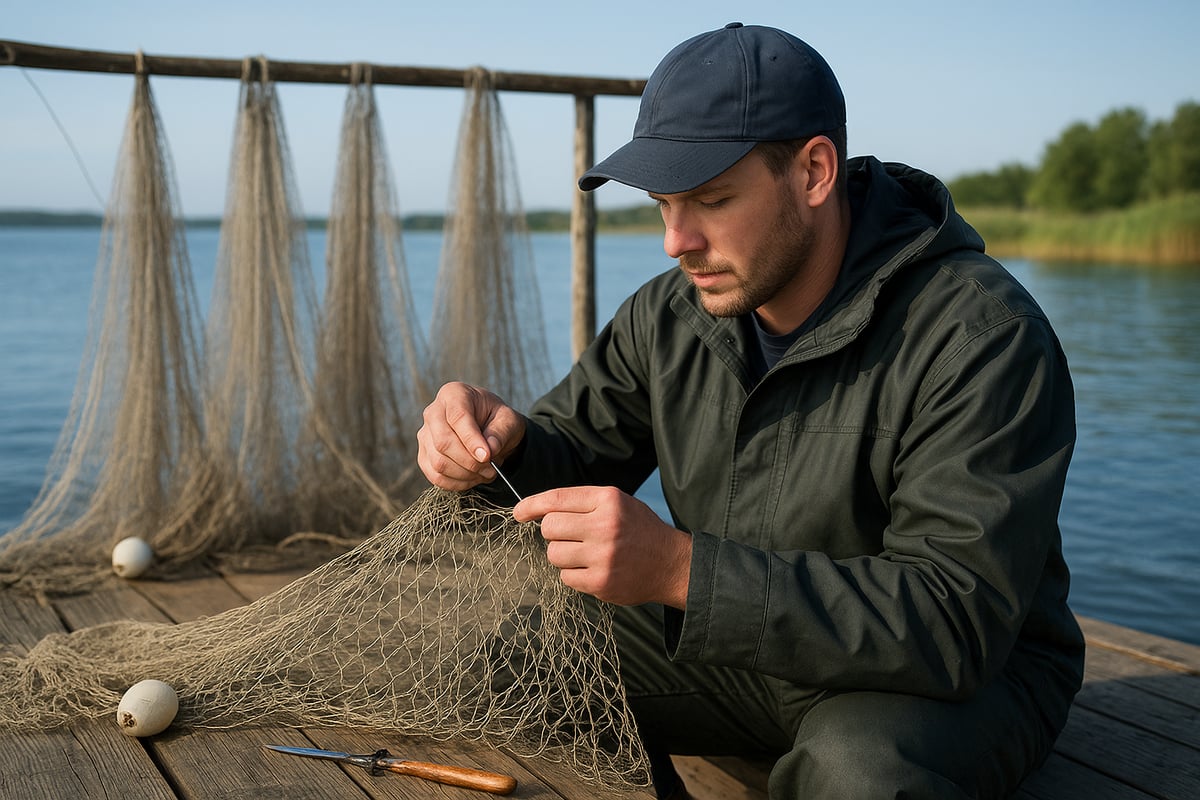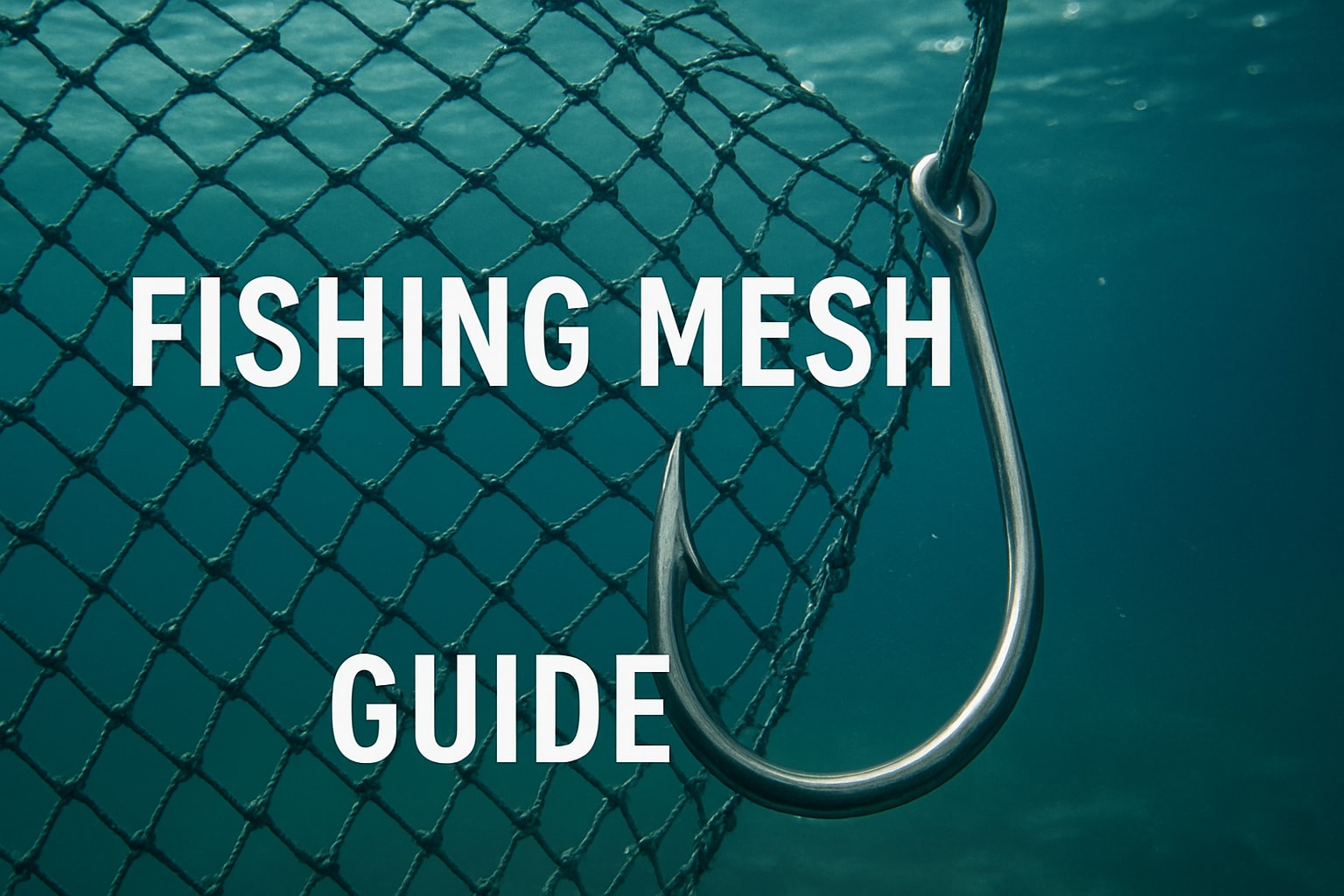Mesh nets are a vital tool for today’s anglers, transforming fishing success whether you cast a line for fun or depend on the catch for your livelihood. Choosing the right fishing mesh net can be the difference between frustration and a rewarding haul.
This guide brings you expert insights and the latest selection strategies for 2025, helping you navigate net types, materials, mesh sizes, regulations, and care.
Ready to boost your catch rates, solve common netting challenges, and maximize efficiency on the water? Follow our step-by-step approach to select the best fishing mesh net for your needs and make every trip more productive.
Understanding Fishing Mesh Nets: Types & Applications
Modern angling relies on the right fishing mesh net for both efficiency and conservation. From commercial harvests to weekend outings, the right net type can dramatically impact results and sustainability. In this section, we break down the diverse world of fishing mesh net designs, their applications, and what sets each apart in 2025.

Overview of Fishing Mesh Net Types
The fishing mesh net landscape in 2025 offers a wide spectrum of designs, each tailored for specific fisheries and target species. Choosing the right fishing mesh net starts with understanding these types and their core functions.
Below is a summary table of the most common net types and their primary uses:
| Net Type | Typical Use Case | Example Species |
|---|---|---|
| Gill Net | Commercial harvest, stationary | Walleye, Whitefish |
| Seine Net | Baitfish collection, shoreline use | Minnows, Shiners |
| Cast Net | Quick throws, live bait capture | Mullet, Sardines |
| Trammel Net | Multi-layer, selective capture | Cisco, Herring |
| Dip Net | Individual fish or bait retrieval | Smelt, Baitfish |
| Specialty Nets | Custom, targeted fisheries | Smelt, Block, Umbrella |
Gill nets are a staple in commercial walleye operations, designed to entangle fish by their gills as they swim through the mesh. In contrast, seine nets excel at sweeping baitfish along shorelines, ideal for both recreational and research purposes. Cast nets provide quick, targeted throws in shallow waters.
Specialty nets, like lift nets or block nets, serve unique roles for targeted species such as cisco, whitefish, and herring. Duluth Fish Nets alone offers over a dozen distinct fishing mesh net types, each refined for specific fisheries and local conditions.
For a comprehensive breakdown of net varieties, visit the Types of Fishing Nets Overview, which details design features, advantages, and common applications.
Key Applications and Fishing Scenarios
Selecting a fishing mesh net is not just about type, but also about matching the tool to the fishing environment and scenario. Shoreline netting calls for lighter, more maneuverable nets like seine or dip nets, while boat-based operations can accommodate larger, heavier gill or trammel nets.
Freshwater fisheries often favor fine-mesh designs for sensitive species or juvenile fish, while saltwater environments demand corrosion-resistant materials and robust construction. Seasonal changes drive net choice as well, with smelt runs or baitfish seasons requiring specific mesh sizes and deployment strategies.
Regulatory considerations are critical. Local laws may dictate allowable mesh sizes, net lengths, and even deployment methods, especially for commercial operations. For example, Minnesota restricts gill net mesh sizes to protect non-target species and ensure sustainable harvests.
A practical illustration is the use of mini fyke nets in shallow lakes. These compact nets are invaluable for sampling fish populations in research and conservation projects, allowing precise targeting and minimal habitat disturbance.
Understanding the interplay between fishing mesh net type, environment, and regulation is essential for successful and responsible fishing in 2025.
Mesh Size, Material & Strength: What Matters in 2025
Selecting the right fishing mesh net for 2025 means understanding how mesh size, material, and strength directly impact your catch and compliance. Each factor plays a key role in optimizing your results, protecting fish stocks, and ensuring your investment lasts.

Mesh Size Selection
Mesh size is the first critical factor when choosing a fishing mesh net. The size of the mesh determines which species you can effectively target and how much bycatch you might encounter. For example, micro-mesh sizes, such as 1/32 inch, are ideal for smelt or other small baitfish, while larger meshes like 1/4 inch heavy-duty are suited for capturing bigger baitfish or juvenile game species.
Selecting an appropriate mesh size is also essential for legal compliance. Many regions set minimum and maximum mesh sizes to protect juvenile fish and promote sustainability. Using the wrong size can result in fines or unintentional overharvesting. To better understand how mesh size and shape influence net performance and catch rates, see Understanding Mesh Size and Shape in Netting.
Mesh size impacts not just what you catch, but also how you fish. Smaller mesh sizes may increase bycatch if not matched carefully to your target species. Proper selection of fishing mesh net size supports responsible fishing and helps maintain healthy fish populations.
Netting Materials and Construction
The material and construction of a fishing mesh net determine its durability, visibility, and handling. Common materials include nylon, monofilament, multifilament, and specialty eco-friendly blends. Nylon remains popular for its flexibility and strength, while monofilament offers low visibility in clear water, making it ideal for wary fish.
Construction style is another key consideration. Knotless nets are gentler on fish, reducing injury and supporting catch-and-release practices. Knotted nets, on the other hand, offer increased strength and are often preferred in commercial settings. Break strength varies by product, with options like Delta (around 35 pounds) and Heavy Delta (around 44 pounds) meeting different needs.
In 2025, eco-friendly materials and innovative blends continue to gain traction. These options offer improved sustainability without sacrificing performance. When evaluating a fishing mesh net, balance material choice with your target species, fishing style, and environmental conditions.
Strength and Durability Considerations
A fishing mesh net's lifespan depends on several factors, including UV resistance, abrasion tolerance, and the type of water where it is used. Heavy-duty nets are designed for commercial operations or rough environments, offering superior resistance to wear. Lightweight nets are easier to deploy and retrieve, making them ideal for quick or recreational outings.
Regular exposure to sunlight and abrasive surfaces can degrade net fibers, shortening their useful life. Commercial fishing mesh nets often require replacement every one to three years, depending on frequency of use and care. Choosing a net with reinforced edges and high-quality materials will maximize longevity, making it a smart investment for regular anglers.
Proper maintenance and thoughtful selection ensure your fishing mesh net remains reliable trip after trip.
How to Choose the Right Fishing Mesh Net: Step-by-Step Guide
Selecting the best fishing mesh net requires a systematic approach tailored to your needs. With so many designs, materials, and regulations, making the right choice can feel daunting. Follow this step-by-step guide to ensure you invest in the ideal fishing mesh net for your 2025 season.

Step 1: Define Your Fishing Goals & Target Species
Start by clarifying your primary fishing objectives. Are you targeting baitfish in shallow streams, or going after larger species like walleye in open water? The fishing mesh net you choose should match your target species and the environment you fish in.
For recreational anglers, a seine net may be ideal for collecting baitfish. Commercial operators might prioritize a gill net for species like walleye. Consider the typical size and behavior of your target fish, as well as whether you fish in freshwater or saltwater.
Step 2: Understand Local Regulations & Compliance
Before purchasing any fishing mesh net, check your local and regional regulations. Laws often specify allowable mesh sizes, net types, and usage periods. Compliance is crucial to avoid fines and protect fisheries.
For example, in Minnesota, gill net mesh sizes are strictly regulated to ensure sustainability. Some regions require special licenses or catch reporting. Always confirm legal requirements for your chosen fishing mesh net before heading out.
Step 3: Assess Mesh Size, Material, and Net Type
Mesh size directly affects what you catch. Smaller mesh sizes, such as micro-mesh, are best for smelt and minnows, while larger mesh sizes suit bigger baitfish. Material choice, such as nylon or monofilament, influences the net’s strength and visibility.
When assessing fishing mesh net options, match the mesh size to your target species and legal limits. Specialty nets, like trammel or fyke types, may be necessary for unique situations. For a visual comparison of net types and advice on selection, explore the Fishing Net Review Videos for practical demonstrations.
Step 4: Evaluate Net Features & Accessories
A high-performing fishing mesh net is more than just mesh. Key features include floats, lead lines, ropes, and marker buoys. Accessories like reinforced edges, sturdy frames, and repair kits can extend the net’s lifespan.
Consider whether you need seine poles for easier deployment or extra floats for buoyancy. Commercial users often benefit from heavy-duty construction, while recreational anglers may prefer lightweight, portable designs. Make sure your fishing mesh net comes with the right accessories for your application.
Step 5: Budgeting & Sourcing Quality Nets
Fishing mesh net costs vary based on size, material, and craftsmanship. Expect to pay between $2.59 and $10.40 per foot for knotless netting from reputable suppliers. Balance your budget with the expected longevity and performance of the net.
When sourcing, prioritize established manufacturers known for consistent quality. Compare prices, warranties, and customer service. Investing in a durable fishing mesh net often saves money in the long run by reducing replacement frequency.
Step 6: Maintenance, Storage, and Repairs
Proper care is essential for any fishing mesh net. After each use, clean and dry the net thoroughly to prevent rot and odor. Store it in a cool, shaded area to minimize UV and rodent damage.
Use repair kits and mending needles to fix minor tears promptly. Good maintenance habits will maximize your fishing mesh net’s lifespan, ensuring reliable performance season after season.
Expert Tips for Maximizing Net Performance & Longevity
A well-maintained fishing mesh net is essential for consistent results and long-term value. By following expert practices for deployment, inspection, storage, and safety, anglers can boost catch rates and extend the life of their gear.

Proper Net Deployment Techniques
Effective deployment of any fishing mesh net begins with preparation. Choose a clear area free from obstacles and carefully lay out the net before use. This reduces tangling and ensures smooth, even spreading in the water.
- For fyke and hoop nets, maintain tension on the lead line as you set the net. This helps keep the net open and functional.
- When using seine or cast nets, throw with a consistent motion to maximize coverage and avoid bunching.
- Always retrieve nets slowly, allowing fish to move toward the net's center and minimizing escape.
Practice makes perfect. Take time to learn the proper technique for each type of fishing mesh net you use. This not only improves efficiency but also protects the net from unnecessary stress and damage.
Routine Inspection and Maintenance
Regular inspection is key to maximizing the lifespan of your fishing mesh net. Before and after each use, check for holes, fraying, or damaged floats and leads. Early detection of small issues prevents major repairs later.
- Clean your fishing mesh net thoroughly with fresh water after every trip, especially when used in saltwater. This removes debris and reduces the risk of rot.
- Dry the net fully before storage to prevent mildew and odor.
- Keep a basic repair kit, including mesh patches, twine, and a mending needle, on hand for quick fixes in the field.
For step-by-step repair guidance and recommended supplies, consult these Net Construction and Mending Tips. Routine care not only maintains performance but also upholds compliance with regulations.
Seasonal Storage and Care
Proper storage protects your fishing mesh net from environmental damage. After each season, wash and dry the net completely, then store it in a cool, shaded area away from direct sunlight.
- Hang nets off the ground to prevent rodent or insect damage.
- Store nets loosely to avoid creasing or weakening the mesh.
- Use breathable bags or containers to allow air circulation and deter mold.
If space is limited, coil the fishing mesh net gently and avoid stacking heavy items on top. These simple steps can add years to your net's service life and ensure it is always ready for action.
Safety and Sustainability Practices
Handle every fishing mesh net with care to protect yourself and aquatic life. Always wear gloves when working with weighted nets or hooks to prevent injuries.
- Select appropriate mesh sizes to reduce bycatch and promote sustainable fishing.
- Use knotless, fish-friendly nets to minimize harm during catch-and-release.
- Dispose of damaged nets responsibly, following local guidelines for recycling or disposal.
Commit to ethical use of your fishing mesh net by following best practices for deployment and maintenance. This not only increases your success on the water but also supports the health of fisheries for future generations.
Innovations & Trends in Fishing Mesh Nets for 2025
Innovation is rapidly transforming the fishing mesh net industry as we move into 2025. New materials, smarter designs, and evolving digital tools are reshaping how anglers and fisheries operate. Staying updated with these trends is essential for anyone looking to maximize efficiency and sustainability in their fishing operations.
Advances in Net Materials and Design
The evolution of fishing mesh net materials is a defining trend for 2025. Manufacturers are introducing biodegradable fibers that break down naturally, helping to reduce environmental impact. Low-visibility monofilament nets are becoming more popular, making them less detectable to fish and increasing catch rates.
Knotless netting is also gaining traction due to its fish-friendly properties. These nets minimize scale loss and injury, supporting responsible catch-and-release practices. Smart nets, featuring embedded tracking or monitoring systems, allow for real-time data collection and improved resource management. For a deeper dive into these advancements, see Innovations and Trends in Fish Nets for 2025.
Eco-Friendly and Regulatory Trends
Sustainability is at the forefront of fishing mesh net development. Regulatory bodies are encouraging or mandating the use of selective gear that reduces bycatch and protects juvenile fish populations. For example, experimental gill nets are being trialed for research and conservation, focusing on species-specific targeting.
Eco-conscious anglers and commercial operators are adopting nets made from recycled or renewable materials. Compliance with updated mesh size and catch regulations is critical. For current legal requirements surrounding small-mesh fisheries, refer to NOAA Fisheries 2024-2026 Small-Mesh Multispecies Specifications. By integrating these trends, the fishing mesh net industry is promoting both environmental stewardship and effective resource management.
Customization and Modular Net Systems
Customization is now a key advantage for fishing mesh net buyers. Modular net systems allow fishers to adapt quickly for different species and changing environments. This trend is particularly valuable for commercial operators targeting multiple fisheries throughout the season.
Custom manufacturing options are on the rise, offering nets tailored to precise mesh sizes, materials, and configurations. The growing demand for custom fishing mesh net solutions in markets like the Pacific and New Zealand reflects a shift toward specialized, high-performance gear. Modular systems also make repairs and upgrades easier, extending the usable life of each net.
Digital Tools and Resources for Buyers
Digital innovation is simplifying the fishing mesh net selection process. Online catalogs now provide detailed product specs, high-resolution images, and user-generated reviews. Virtual fitting tools help buyers visualize net dimensions and features before making a purchase.
Some suppliers offer interactive guides to match the right fishing mesh net to specific target species and regulations. This digital support ensures anglers and commercial buyers can make informed choices quickly and confidently. As a result, the industry is seeing improved satisfaction and reduced costly mistakes when selecting new gear.
Leading Fishing Mesh Net Brands & Where to Buy in 2025
Selecting the right fishing mesh net brand is crucial for both reliability and performance. The market in 2025 offers a wide range of options, each with unique strengths and specialties. Understanding which brands lead the industry can help you secure the best equipment for your fishing needs.
Overview of Top Brands and Manufacturers
When evaluating a fishing mesh net, the manufacturer’s reputation and product range are key factors. Established brands such as Duluth Fish Nets are renowned for their extensive selection, offering solutions for commercial, community, and recreational fisheries. Their nets are designed for diverse applications, from gill nets for commercial walleye to specialty nets for research and conservation.
Another respected name is Action Outdoors Limited, well known in the Pacific and New Zealand markets. They produce ready-to-use nets in a variety of mesh sizes and materials, catering to both large-scale operations and local fishers. These brands invest heavily in quality assurance, ensuring durability and regulatory compliance.
Here’s a quick comparison of top fishing mesh net brands:
| Brand | Product Range | Region | Specialty | Customer Support |
|---|---|---|---|---|
| Duluth Fish Nets | Gill, seine, specialty | North America | Custom netting, research | Excellent |
| Action Outdoors Ltd. | Commercial, modular | Pacific/NZ | Species-specific, export | Responsive |
| Others (generic) | Basic nets | Global | Budget options | Varies |
Choosing the right fishing mesh net often depends on the target species, water conditions, and regulatory requirements. Brands that offer detailed specifications and customization help fishers achieve optimal results. For a comprehensive look at net types and their uses, see Commercial Fishing Nets: Sizes, Types, and Applications Explained.
How to Compare and Choose Retailers
Finding a trustworthy retailer for your fishing mesh net purchase can make a significant difference in satisfaction and value. Start by comparing product information across sellers. Reputable retailers provide clear details on mesh size, net material, and intended application.
Consider these criteria when evaluating retailers:
- Transparent pricing and warranty policies
- Detailed product descriptions and certifications
- Shipping options and after-sales support
- Verified user reviews and feedback
For example, when comparing prices for similar fishing mesh net types, check for included accessories like floats or ropes. Some retailers bundle essentials, while others offer them separately. Always look for customer service responsiveness and a clear return policy.
User reviews are invaluable. They offer insights into actual net performance, durability, and ease of use. Prioritize retailers with a proven track record and accessible customer support. This approach helps ensure you invest in a fishing mesh net that meets your needs for seasons to come.
After exploring the key differences in mesh net types, materials, and expert selection strategies for 2025, you’re now ready to make an informed choice that matches your fishing goals. Whether you’re gearing up for a commercial season or a weekend adventure, choosing the right net can make all the difference. Action Outdoors Limited offers a wide range of New Zealand made fishing mesh nets, trusted for their quality and reliability across the Pacific. If you’re ready to upgrade your gear and experience the benefits firsthand, you can browse the latest selection and Buy Now.

